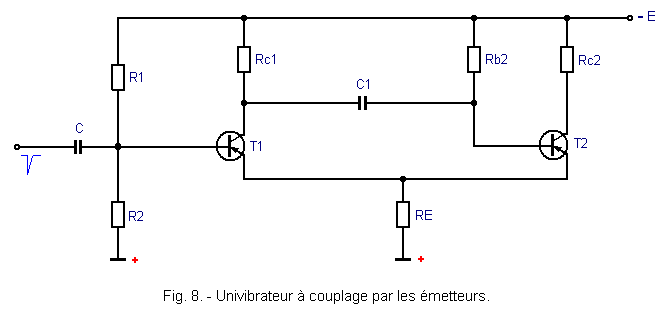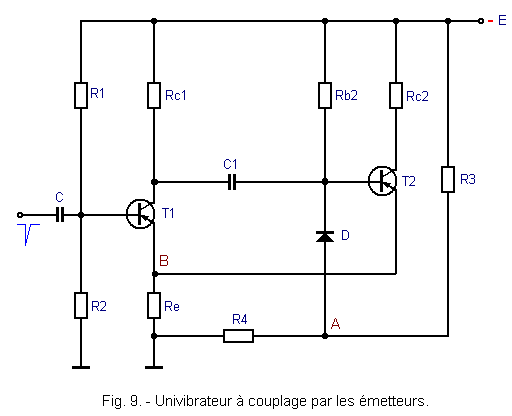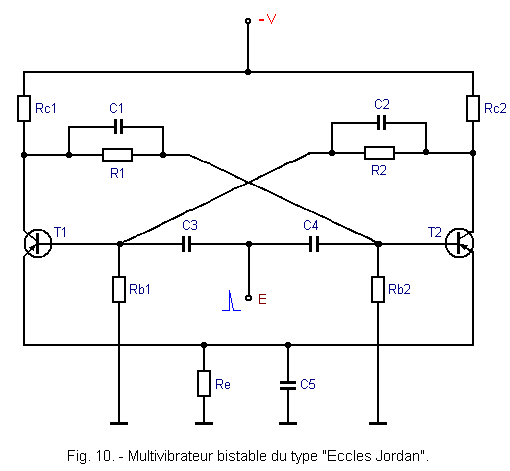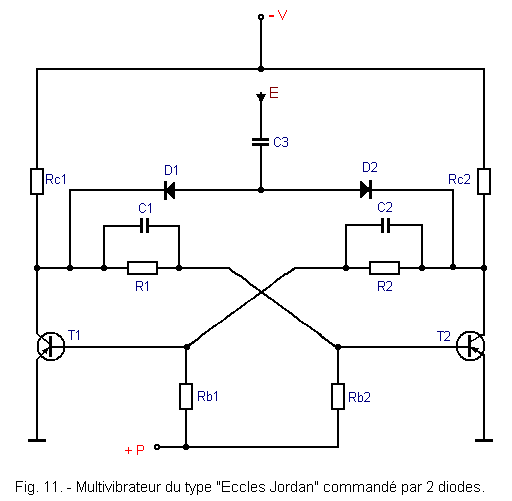The duration of the unstable state is given approximately by the formula : t = 0.7 x (C1 x Rb2).
2. 2. - COUPLING UNIVERATOR BY TRANSMITTERS
This assembly, represented in Figure 8, is identical to the electronic tube circuit that we studied in the theoretical lesson 22.

The transistor T2 is biased by the resistor Rb2, so as to be highly conductive. The transistor T1 is substantially blocked.
The voltage drop in RE reinforces this state of affairs and in the absence of the external signal, there is no reason for this situation to change. The assembly remains stable.
If we apply a negative pulse on the basis of T1, it becomes momentarily conductive and transmits, through C1, a blocking pulse to transistor T2.
The assembly switches and the capacitor C1 discharges through T1, RE, the source - E and the resistor Rb2.
The discharge current maintains a base voltage Vb2 positive relative to that of the T2 emitter which remains blocked.
At the end of a certain time, determined by the time constant Rb2 and C1, the charge of C1 passed through Rb2.
T2 becomes conductive again and re-blocks T1 by the current in RE. The assembly has returned itself to a stable state.
A new control pulse will trigger the switchover and return to the idle state.
The circuit of Figure 9 is also a transmitter-coupled univibrator, but the operation has been improved by the addition of a diode D and two resistors R3 and R4.

It is preferable, for the stability of the assembly, to ensure that the transistor T2 is not at saturation in its conduction state.
Diode D limits the basic negative potential to the value set at point A by the resistor bridge R3 and R4. For the diode to act, the potential of point A must be more negative than that of point B.
Indeed, if the base voltage is not negative compared to that of the transmitter, the transistor T2 never leads.
Depending on the value of the constant potential of the base T1 (potential fixed by the voltage divider bridge formed by R1 and R2), it is possible to vary the conduction of T1 and consequently modify the duty cycle of the output signal.
If this potential is too low, the monostable does not work : when T2 tends to be blocked, the current passing in T1 is low (internal resistance of the high transistor). The discharge current of C1 then produces in Rb2 a voltage drop that is too low to keep T2 locked.
If, on the other hand, the basic potential of T2 is too high, the whole enters permanent oscillations and becomes a multivibrator with coupling by the emitters.
The basic potential of T1 must therefore be between these two critical values.
Unlike the case of electronic tubes, the transmitter-coupled univibrator, if it has the advantage of not requiring a positive voltage source, seems to be discouraged.
The fundamental monostable multivibrator is preferable from the point of view of operational safety, because of the large margins of blocking of transistors T1 and T2.
Monostable multivibrators provide an output pulse for each input pulse.
They mainly serve :
1°) to shape pulses to make them become rectangular signals of amplitude and duration invariable.
2°) delaying the trigger pulse applied to the input ; the triggering of the subsequent stages is then produced by the trailing edge of the output pulse.
Now let's look at the third category of multivibrators : BISTABLES multivibrators, which as their name suggests have two stable states.
 3. - BISTABLE MULTIVIBRATORS
3. - BISTABLE MULTIVIBRATORS
Bistable multivibrators have two stable states. This means that initially, one transistor is blocked and the other driver.
After applying a control pulse, the blocked transistor becomes conductive and the conductive transistor is blocked. A second control pulse brings the fixture back to its original state and so on.
3. 1. - BISTABLE MULTIVIBRATOR OF THE TYPE "ECCLES JORDAN"
The diagram of a bistable transistor type "Eccles Jordan", is shown in Figure 10. Each transistor controls from its collector, the base of the other, by a continuous link, made of a bridge of two resistors R1 - Rb2 and R2 - Rb1.

The values of the resistors and the supply and bias voltages are chosen so that, when one transistor is blocked, it causes the other to lead (in general to saturation) ; when one transistor is charging, it causes the other to block.
The assembly is carried out as symmetrically as possible, the two transistors have the same characteristics, the collector resistances are equal and the resistor bridges are made with paired elements.
As soon as the power is turned on, both transistors tend to drive. Although the mounting is symmetrical, the two collector currents are not exactly equal. The base voltages resulting from the currents flowing in the resistor bridges R1 - Rb2 and R2 - Rb1 are unbalanced.
Very quickly and thanks to the cumulative effect, the assembly is in a stable state (for example T1 driver and T2 blocked). It is this state that we will call "state of rest".
Let's send through C3 and C4, a positive trigger pulse.
The transistor T1 sees its base becoming positive with respect to its transmitter and it locks. The transistor T2 already blocked does not undergo any change in operation during the duration of the pulse.
From the beginning of the blocking of T1, the collector potential Vc1 begins to rise. This rise towards the negative value - V is transmitted to the base of T2, partly by the bridge R1 - Rb2, and totally by the capacitor C1.
The base of T2 becomes negative with respect to the transmitter and the transistor T2 begins to drive.
The collector potential of T2, initially at the value - V, changes to a less negative value (- V - Ic2 x Rc2).
The positive variation transmitted to the T1 base by the R2 - Rb1 bridge and C2 blocks T1.
T2 collector voltage remains low (conductive T2), the voltage brought by the bridge R2 - Rb1 on its base T1, is not sufficient to unlock T1.
We thus obtain a new stable state which is : T1 blocked, T2 conductive.
A new positive impulse will block T2. Raising the collector voltage Vc2, transmitted by the link circuit to the T1 base, unlock the latter. The assembly returned to the state of rest.
The bistable multivibrator can be controlled indifferently by positive or negative pulses applied to the bases of the transistors.
Another solution is to send the control pulses on the collectors of the transistors through two diodes.
The scheme of Figure 11, shows a bistable Eccles Jordan, controlled in this way.

In this arrangement, the transmitters are connected directly to the ground. The polarization of the transistors is obtained thanks to a positive voltage + P applied to the bases of the transistors, through Rb1 and Rb2.
The diodes D1 and D2 make it possible to "direct" the control pulses on the collector of the transistor which is blocked.
Suppose T1 is conductive and T2 blocked. Apply by the capacitor C3, a positive pulse on the anodes of the two trigger diodes.
Diode D2 has its cathode connected to the T2 collector. The latter being blocked, the collector voltage is close to the negative potential - V.
The diode D2 is therefore highly conductive and it transmits without attenuation the control pulse.
On the other hand, the diode D1 has its cathode brought to a very little negative potential (the transistor T1 leads to saturation and the collector voltage is low).
When the positive pulse arrives, the diode D1 is still conductive, but less than D2. The pulse that appears on the T1 collector is attenuated by the resistance presented by the diode D1.
The positive pulse through D2 will be transmitted by R2, Rg1 and C2, the base of the transistor T1, which will lock. The assembly switches at this moment into the other stable state, that is to say : T1 blocked and T2 conductive.
We end our explanations on the astable, monostable and bistable multivibrators based on transistors and we will take between some special circuits, negative clippers, positive clippers and mixed clippers.



 Astable Multivibrators based on Transistors
Astable Multivibrators based on Transistors Click here for the next lesson or in the summary provided for this purpose.
Click here for the next lesson or in the summary provided for this purpose. Next Page
Next Page